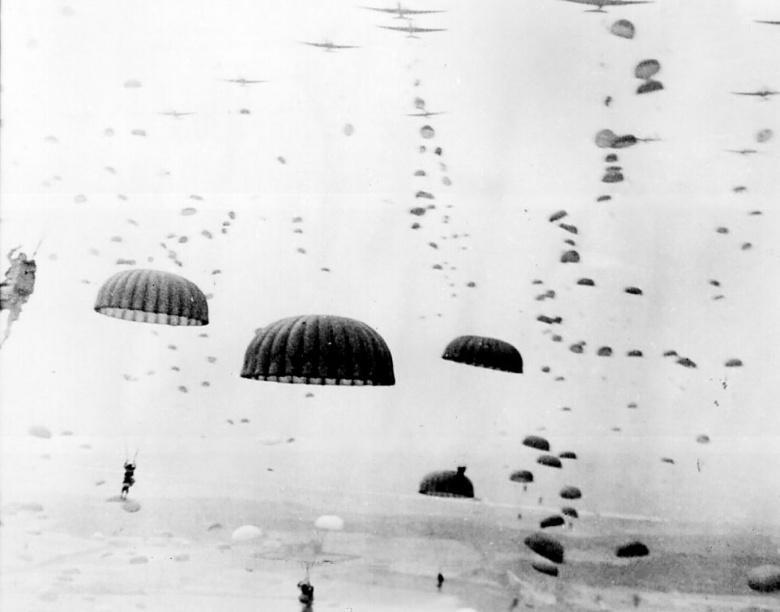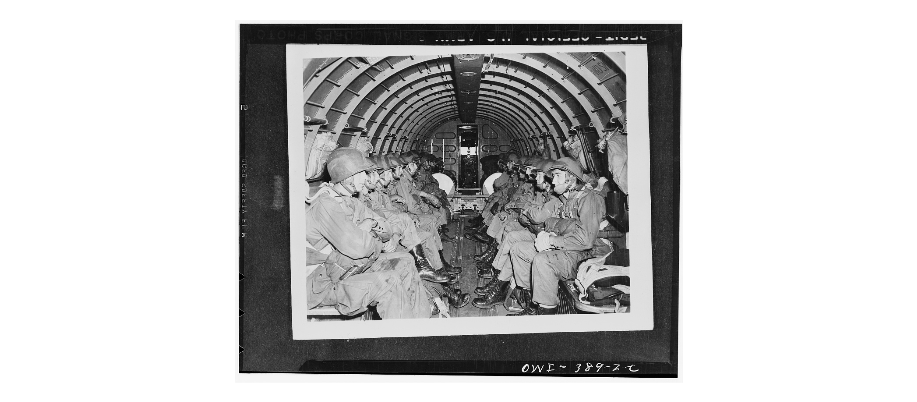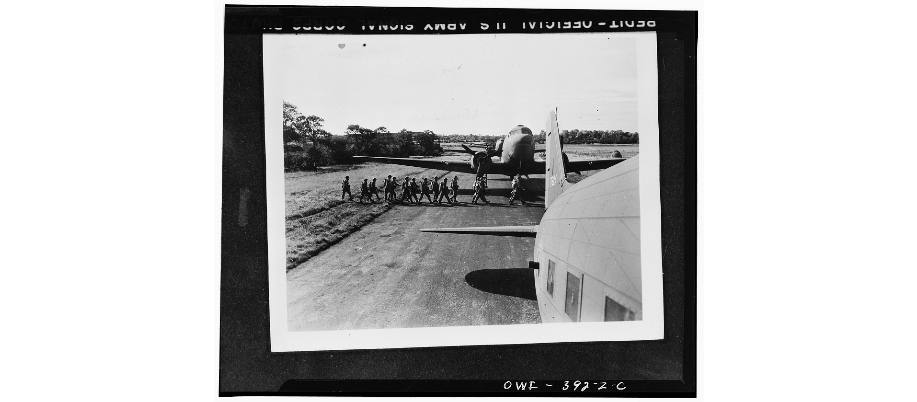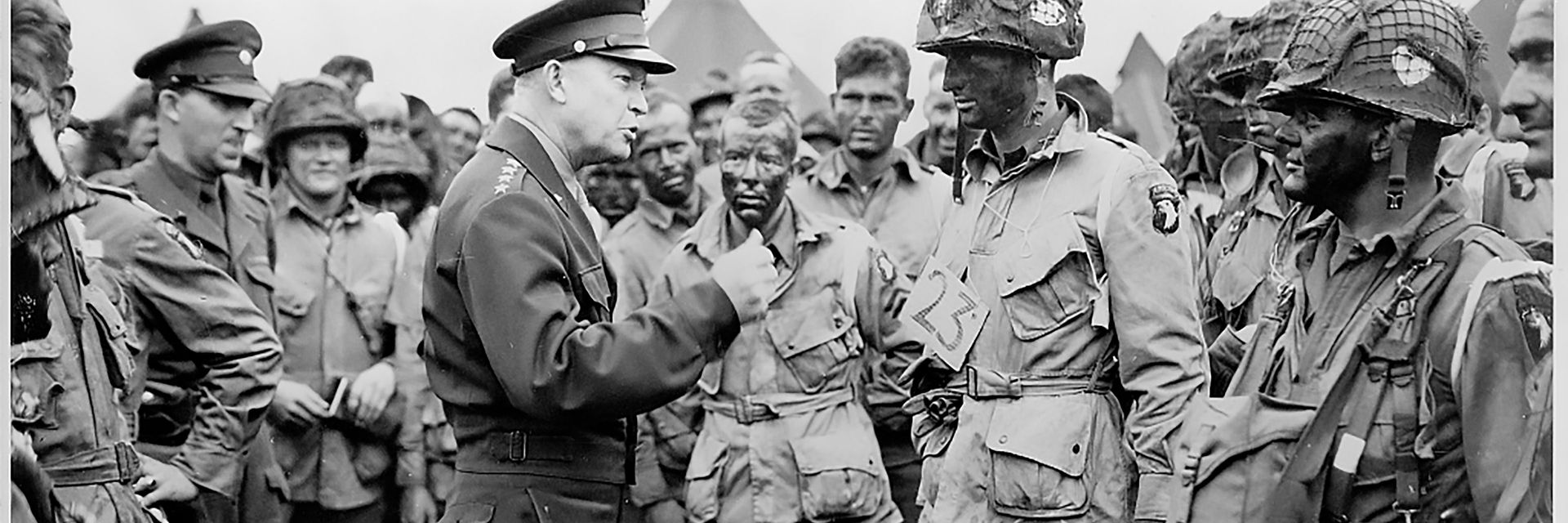June 6th marks the 75th anniversary of D-Day and the Allied forces’ historic invasion of Normandy, France. To commemorate this anniversary, we take a look back on that fateful day and the brave paratroopers who risked – and in all too many cases lost – their lives supporting the main thrust of the attack on Normandy’s beaches. The paratroopers played an integral part in the eventual success of D-Day. But who were they, and how did they do it?
◊
On a normal day, the cliffs of Normandy drop to a beautiful shoreline full of crystal blue water and soft, white sand. But June 6, 1944, was not a normal day, and the coastal waters were not dappled by bright sunshine – they were splashed with red and dotted with the bodies of fallen soldiers.
On that fateful day, hours before landing craft delivered huge divisions of Allied forces to the beaches, over 20,000 American, British, and Canadian paratroopers launched themselves from aircraft in the dark of night. Filled with anticipation and perhaps a bit of terror, their young bodies pumping adrenaline, the warriors fell into what would end in either oblivion or glory.

Paratroopers dropping through the sky above Holland.
(Image courtesy of National Archives at College Park, via Wikimedia)
The descent was an act of trust; the attack, disorganized. Some soldiers landed safely, ready for battle, while others were scattered throughout the Peninsula – unsure of where they had actually landed. An incredible number of lives were lost that day (some even before they had reached the ground), and within only 24 hours, 2,499 American paratroopers were killed, injured, or missing. But who were these fallen heroes? And who were the men that remained standing?
“As we left the plane we had flak, machine-gun fire and everything else all the way down, because we were sitting targets.” – Ken Russell, 82nd Airborne Division
Who Were the Paratroopers Who Fought on D-Day?
The Allied paratroopers came from all walks of life. They were from big cities like St. Louis, Liverpool, and Toronto, and from small towns in Nebraska, Sussex, and Manitoba. And they were mostly young, very young, many of them only a year or so out of high school. What does that old Phil Ochs protest song say? “It’s always the old to lead us to the war / It’s always the young to die.” And so it was on D-Day.
The great war machine drafted them, trained them, and gathered them into the famed American 82nd and 101st Airborne Divisions; the British 6th Airborne Division; and the 1st Canadian Parachute Battalion. And when the night of June 5-6 arrived, they climbed into the C-47s and prepared to do their duty.
“With the roar of the engines in my ears, I was out the door and into the silence of the night. I realized I had made the jump into darkness.” – Tom Pocella, 82nd Airborne Division
So what were their goals? There were three main objectives: The paratroopers would aid in seizing routes linking the beaches to the inland; they would secure road junctions and other tactically important sites; and they would take control of the two bridges on the Merderet River. To accomplish these missions, they needed not only their training, their determination, and their courage – they also needed some luck.
D-Day Paratroopers and the Dumb Luck of Fate
Soldiers who jumped successfully from the transports were thrown into battle upon touchdown. But many of the airdrops weren’t as accurate as intended. One problem was that the devices that were to guide their C-47 transport planes to the designated Drop Zones (DZs) were too frequently unreliable. A lot of the DZ markers, well, missed their marks. Marker lights were lost at sea. And planes flew well past their zones when pilots failed to see turning points or had to break from their planned courses.

Paratroopers preparing to jump during maneuvers over England.
(Image courtesy of U.S. Library of Congress)
As a result, paratroopers often found themselves significant distances from their intended DZs, and the fates of the troopers were sometimes determined by dumb luck. Said John Taylor of the 101st Airborne Division, “Those who jumped from the C-47 before me drowned in a marsh, just like those who jumped after me. I landed on a thin strip of land a few meters wide that crossed the marshes.”
While the attack was shambolic, it was still effective. Even paratroopers who fell off mark often took the German enemy by surprise, and the chaos turned into a successful ambush. The German defenders were unsure of where the attacks were coming from, and where to fight back – and they, themselves, became disorganized and disoriented.
For Paratroopers, the ‘Chute Can Produce Quite a Jolt
Paratroopers, like other combat teams, had specialized equipment for their missions. Perhaps the most important item for these airborne soldiers was, of course, the parachute itself.
“I shuffled up, glancing down and stopped, dumbfounded. All I could see was water, miles and miles of water. But this was D-Day and nobody went back to England, and a lot of infantry riding in open barges seasick to the low-tide beaches were depending on us … and so … I grabbed both sides of the door and threw myself out.” – David Kenyon Webster, 101st Airborne Division
Each paratrooper was equipped with T-5 parachutes – a parachute that, when opened, delivered a shock equivalent to five times normal gravity. Think that’s rough? Each paratrooper had to handle that blow while loaded down with about 88 pounds of equipment. And holding on to all the equipment was a feat in itself. When the parachutes opened, the sudden deceleration often resulted in the separation of weapons and equipment from the fighters.
“I had a violent opening shock. A .45 pistol that I had holstered on my hip, as well as my canteen, tore away. I looked up and saw a blown panel in my parachute.” – Marion Grodowski, 101st Airborne Division.
Remembering the Paratroopers of D-Day
As the doors opened, the paratroopers held their breaths and trusted in their training and blind faith. I’ve never been a fan of heights, and the thought of stepping out of a plane, weighted down with equipment and violently deploying parachutes, and no idea where I’m going to land absolutely terrifies me. Throw in the very real threat of enemy forces waiting on the ground to kill me, and I am definitely thankful for the brave souls who fought for our country on D-Day.

Paratroopers preparing to board their aircraft for maneuvers in England.
(Image courtesy of U.S. Library of Congress)
It’s been 75 years since the monumental battles of D-Day, and the world is looking back to commemorate this historic event. Some have found unique ways to remember those who fought. One such individual, Warren Johnson of St. Louis, is honoring his grandfather’s brother by traveling to Normandy to reenact the D-Day jump – parachuting from the same C-47 that carried his granduncle 75 years ago.
I cannot imagine what these men went through that historic day, and throughout the war, nor can I fathom what they must have felt as they performed their duty on that fateful morning. What we can do, however, is remember and pay tribute to those who fought hard for us … not just on the 75th anniversary, but through all our history.
Ω
Title image: General Dwight D. Eisenhower gives the order of the day, "Full victory--nothing else" to paratroopers somewhere in England, just before they board their airplanes to participate in the first assault in the invasion of the continent of Europe, 1944 June 6. (Source: The Library of Congress)

